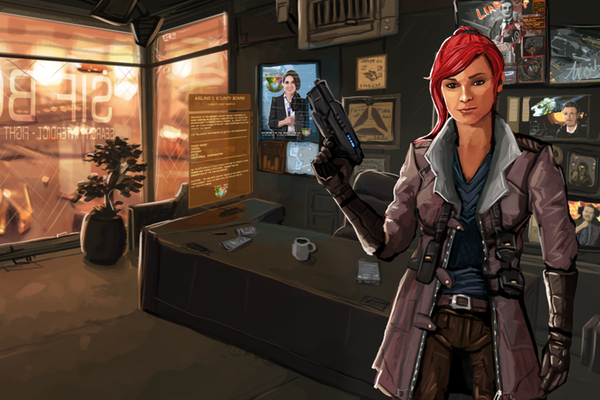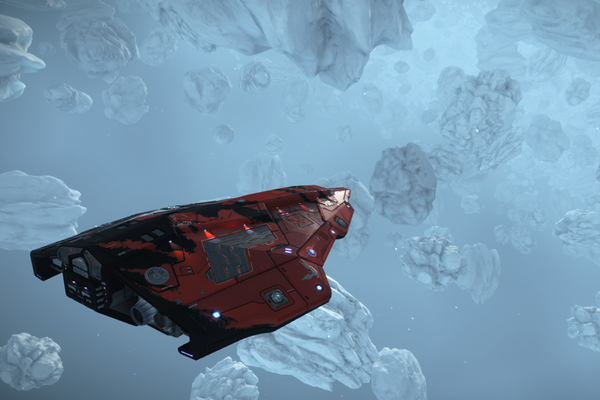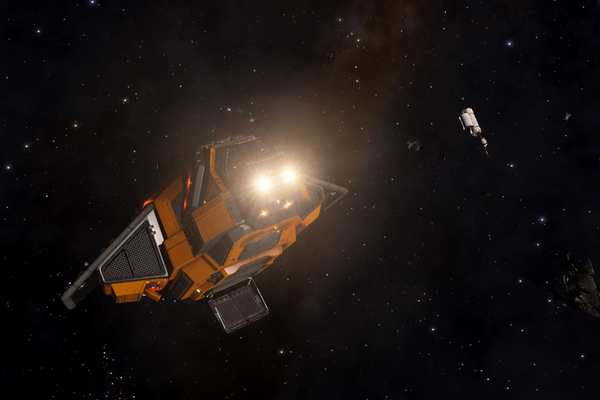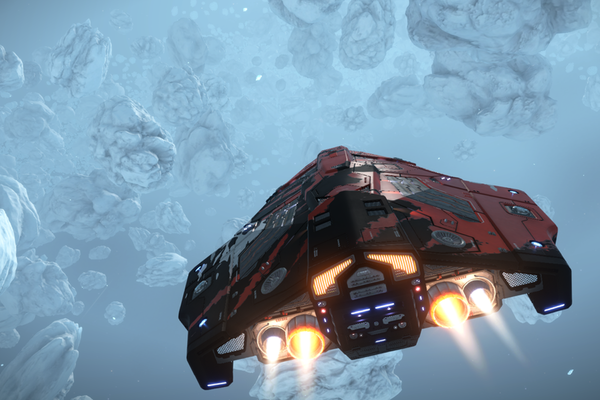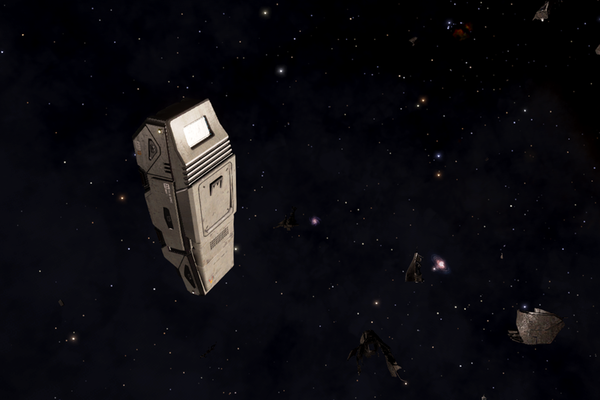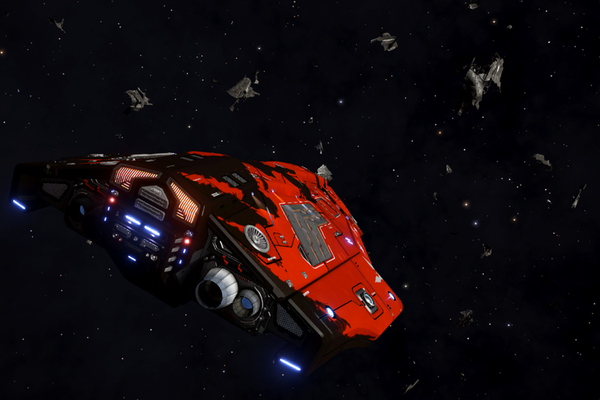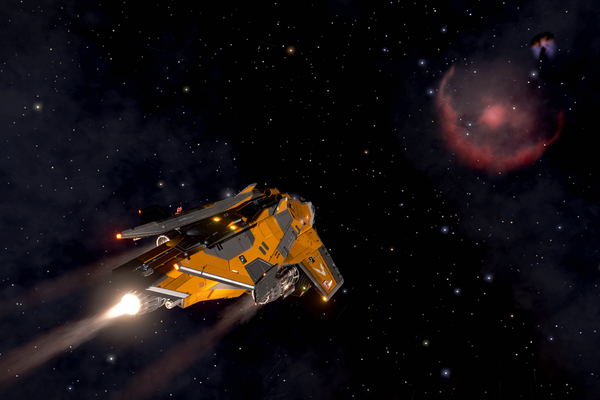DISCLAIMER: I am, by no means, advocating slavery in any form in this post. The fact remains that Slaves, both those sanctioned by the Empire and unsanctioned, exist in Elite: Dangerous as a commodity that often needs to be smuggled. As a sandbox game, no player is ever forced to engage with or traffic in slaves. I only provide this disclaimer because I am aware that it has been a topic of contention amongst players. What anyone chooses to do with the information I provide here is up to them. If the topic or mention of Slavery upsets you, it’s probably best you not read any further.
Throughout human history, wherever governments have sought to impose duties or prohibitions on goods, services, and people, there have been those willing to illegally transport and sell them. Merchants and Traders, possessed of a lust for profit and loose morality have, throughout history, flouted embargoes to bring the things people want, but maybe shouldn’t have, to Black Markets where they are sold at vast markups. Revolutionaries and war profiteers alike have also sought to contravene totalitarian law to snake in aid where it was needed, either as an act of charity or for profit.
In short, Smugglers have plied their trade as long as the rule of law has cast its morally ambiguous shadow over humanity, and it is no different in the distant future of Elite: Dangerous. Commodities readily sold in one system yet banned in another, salvaged cargo, illegal artifacts, probes, and AI components, and even slaves all provide opportunities for amoral Traders to make Credits. And make no mistake, Smugglers are really just Traders with more guts than sense.
The Job
There are several types of Smuggling in Elite: Dangerous, but the only tangible ways in which Smugglers differ from Traders are in how they acquire their goods and where they sell them. Like Traders, Smugglers can make use of the Commodities Markets and Mission Boards in the Starport Services of stations. Whereas a Trader will buy legal goods in one system and then sell them in another system where those goods are also legal, a Smuggler will buy goods legal in one system and then sell them to a Black Market in a system where those goods are illegal. Additionally, a Trader might accept a mission to transport or source legal goods, while a Smuggler might accept a mission to smuggle, or snake in, contraband.
While the above described are the most common forms of Smuggling in-game, there are others. For example, any cargo drifting in space is still, much like our current real life maritime laws, considered the property of whomever owned the originating wreck. If a pilot scoops up said flotsam with their Cargo Scoop, the cargo is labeled as Stolen, and can only be jettisoned or sold at a Black Market. In this way, Scavenging and Smuggling go hand in hand in Elite: Dangerous.
Whether you’re smuggling artifacts, narcotics or weapons, medicines to embargoed systems, unsanctioned slaves into Imperial space, or Imperial Slaves into Federation or Alliance space, the job is the same: get the goods and transport them somewhere to be sold, all while avoiding System Authority and Pirates. The type of Smuggling you are doing, though, does have a big impact on which ship you use and how you outfit it.
The Ship
The different types of Smuggling in Elite: Dangerous really boil down to how and where the contraband was collected, and how far away the Smuggler intends to sell it. This can be distilled further to: Salvage Smuggling and Long Range Smuggling.
Salvage Smuggling requires a ship with an available Cargo Scoop; every ship has one, it just requires enough available power to power it. A well armed and shielded ship is also beneficial as some of the Unidentified Signal Sources (USS), where salvage is found, can be occupied by Pirates. A Salvage ship is also well served by a Scarab SRV, allowing it to collect salvage and resources on planetary surfaces. Good Thrusters and Power Distributor are also useful when making a run for it. There are also occasions when the nearest Black Market is some distance away, so a good Frame Shift Drive and even a Fuel Scoop are handy to have. Overall a smaller, more maneuverable ship is best suited for salvage work, allowing the Smuggler to quickly scoop up flotsam and easily land on planetary surfaces. Of course, the ship also needs cargo space, but most salvage locations only have a handful of tons, so not a lot is required. You could use a larger ship for salvage work, allowing you to outfit a Collector Limpet Controller, better weapons, and more cargo space, but I’ve found the tasks are more enjoyable in a smaller ship. Your mileage may vary.
Long Range Smuggling should be done in a ship of Medium class or smaller. This is due to the fact that many of the far flung, inhabited systems on the edge of The Bubble are Outposts and do not have Large landing pads. Because, as the name implies, Long Range Smuggling involves traversing great distances (300 – 400 light years on average in one run), an A rated Frame Shift Drive is essential. This type of Smuggling also involves picking up Smuggling missions from the Mission Boards of these outer rim ports. This means, as part of the missions, both Pirates and System Authority will be sent to find the Smuggler. Having extra Fuel Tanks, reducing or eliminating refueling stops and scoops, and good Thrusters and a top rated Power Distributor will go a long way toward successful mission completion. A Fuel Scoop is useful in reaching some of the more distant systems, but should not be used during the actual Smuggling run. Overall, the lighter the ship, the better (to minimize the number of jumps), but Cargo Racks are, of course, needed as well. A Smuggler can also earn some extra Credits by outfitting a Discovery Scanner, but this isn’t necessary.
Doing the Work …
Long Range Smuggling
Long Range Smuggling can be done in a few of ways. The most common, and arguably the most lucrative of any profession currently in-game, involves traveling out to one of a handful of outer rim systems, accepting smuggling missions from local factions in those systems, and then delivering contraband 300 – 400 light years back into The Bubble.
The governing Superpower in each system is a determining factor in the types of contraband the local factions will have available for Smuggling. Imperial systems, like Robigo, Quince, and Fehu often have missions to smuggle Slaves, Narcotics, or Weapons into Alliance and Federation systems, where these things are typically illegal. Federation systems, like 17 Draconis will often just have high paying courier missions back into The Bubble. Independent systems, like Sothis and Ceos will tend to have a mixture, providing options for players who want want to play Smugglers but want to avoid trafficking in Slaves.
Picking up these missions can be tedious as they aren’t always immediately available upon arriving at the different stations. Most players employ the mode switching mechanic until their cargo holds are full. This mechanic involves accepting whatever smuggling missions are available in Open Play, logging out and back into Solo Play to refresh the Mission Board, accepting the missions that are there, and then switching back to Open Play. The process is repeated until your cargo holds are full. If you’re playing with friends, you can also add Private to the rotation of mode switching. The mode switching mechanic is well known to Frontier, and as far as I know isn’t considered an exploit since it’s been around for well over a year. Still, if you feel like it’s immersion breaking, or if you just don’t want to switch modes, you can also simply wait 10-15 minutes and the Mission Board will refresh. Either way, the idea is to stack as many missions as possible until your cargo hold is full or you reach the maximum allowed number of concurrent missions, currently 20. It should be noted that the higher a pilot’s reputation with the local factions, the more profitable the missions offered will be. Selling Exploration Data is a good way to boost reputation quickly. This is where having a Discovery Scanner would come in handy, apart from the extra Credits it earns you.
There is another, though not nearly as lucrative, option for Long Range Smuggling. It’s sort of a combination of the above described and bulk Trading. You’ll pretty much be doing all the things a Trader does, so it would definitely benefit you to read my post on playing a Trader, but instead of purchasing legal goods in one system and selling them in another system where they are also legal, you’ll be buying goods legal in one system and selling them to a Black Market in a system where those goods are illegal. You’ll need to make heavy use of the Galaxy Map and other trading tools like EDDB to find out where commodities are legal and illegal and where Black Markets are, all described in my post on Traders (seriously, go read it), but it has the added cool factor of allowing you to be a specific type of Smuggler. You can be a drug mule, or a gun runner, or a slave trader, or even a missionary delivering medicines into an embargoed war zone; it all depends on what you’re hauling. In either case, you’ll be well served by all the same ship modules and tactics that the mission running, Long Range Smuggler uses.
Whichever way you choose to pick up your illegal haul, be it missions or bulk Trading, now comes the fun part: making all your illegal deliveries without being scanned. It used to be that being scanned caused any open smuggling missions to fail outright, and all you could do was try to sell your cargo on the Black Market. Now, being scanned takes a huge chunk out of the payout for any open missions, but it’s still worth turning them in. Either way, you want to avoid being scanned at all costs because it, at best, nets you a fine and, at worst, gets you shot at. The best way to avoid scans is to not be Interdicted. Having extra Fuel Tanks, preferably allowing you to jump 300 – 400 light years on a full tank, helps a lot as you’ll be able to move from star to star with little time for anyone to catch you. If you are Interdicted, throttle down to zero, submitting to the Interdiction. Once you’re in normal space, boost away as often as your Power Distributor will allow, dropping chaff, and engage your Frame Shift Drive as soon as it cools down.
Once you arrive at your destination, you must dock with the port without being scanned as well. Rather than go through a lengthy, and potentially confusing, text description of how to do this, I will simply direct you to ThatTinyDude‘s video on avoiding System Authority while smuggling. After you successfully dock, turn in the missions or sell your cargo, and marvel at your full pockets!
Salvage Smuggling
Illegal Salvage Smuggling requires a slightly different tool and skill set than Long Range Smuggling. I’ll be mostly discussing illegal salvage here, but there are legal salvage missions you can pick up from just about any local faction in any system from their respective Mission Boards. Apart from how you dispose of the salvage, there is no difference in the mechanics of collecting it, so these tips should serve the Salvage Smuggler in either case.
Illegal salvage basically involves lurking in the interplanetary space in star systems, in supercruise, looking for Unidentified Signal Sources. USSs can contain any number of things and, once you target one and get close enough, you’ll get a bit more detailed information, including the potential threat level. Apart from netting you a few tons of contraband, without spending a dime, to sell at the nearest Black Market, USSs also have the added benefit of being great places to collect Engineering materials. That said, the mechanics of collecting salvage and/or materials is pretty straight forward.
Once you locate a USS in interplanetary space, target it and approach it in supercruise. As you draw closer, the USS will update giving you some specific information about the signal type and threat level. The signal types you’re most interested in are High Emissions, Encoded, Degraded, and Combat Aftermath. These will generally have a good amount of salvage and materials floating around. Be mindful of the threat level. A 0 typically means there won’t be anything dangerous in the USS (though I have had, on occasion, Pirates swoop in later as I scooped salvage). The highest threat level I’ve seen was a 4, and there was a Pirate Anaconda and three Eagles, waiting to blast me, inside. I have heard of a threat level 5, but have yet to see one.
In any case, once inside, check your contacts list and see what’s floating about. You can pick and choose, or take it all depending on your available cargo space. To grab the flotsam, target it and open your Cargo Scoop, then either slowly fly in and scoop it up, or launch a Collector Limpet. Repeat as necessary for any of the salvage you want, then close your Cargo Scoop, find the nearest Black Market, and high wake out of there. There are also, sometimes, data points in USSs. To collect these, just target them and point your ship at them. Your ship’s scanners will do the rest.
Sometimes you will find Occupied Escape Pods or Occupied CryoPods in USSs. Unfortunately, at present, there is no in-game mechanic for rescuing people apart from selling the pods, and their passengers, to a Black Market. How you choose to rationalize this for your own personal story is up to you. It could be that you are receiving a reward for their rescue and, once dropped off at the Black Market, they’ll be free to go. Or, on the darker side of things, you might be selling them into slavery. The game doesn’t specify other than to mark the pods as Stolen, requiring their sale on a Black Market. You can also choose to just not pick them up. It’s up to you.
Salvage operations can also be conducted on planetary surfaces. This currently involves landing on non-atmospheric, rocky bodies and searching for Points of Interest (POI). These will appear as violet (depending on your HUD colors) ovals on your ships radar. Once you locate one, you land in it and deploy your SRV. From this point on you’re dependent on the SRV‘s Wave Scanner. There are some great sites for interpreting the Wave Scanner, but for the purpose of salvage operations, WaveScanner.Net is best. You’ll want to be looking for Guarded Caches, Lightly Guarded Caches, and Crashed Nav Beacons. These have the most opportunity for salvageable cargo and data points. Once you find some, you may have to dispose of Skimmers guarding the area, but then you can deploy the SRV‘s Cargo Scoop and scoop up what you want in the same manner described above. Unfortunately the SRV can currently only carry 2 tons of cargo, so you’ll need your ship nearby to transfer cargo to, if there is more than that to collect. Planetary Salvage is probably the least lucrative, but it’s loads of fun if you like driving the SRV and also provides ample opportunity to collect Engineering and Synthesis materials. There are also often missions, from local factions, to conduct legal planetary salvage. If you’re really interested in the ins and outs of the SRV Wave Scanner, check out this forum post.
The Black Market
However you get the goods, unless you’re on a missions for a local faction with a specific delivery point, you’re going to need to fence them. Locating Black Markets to do this is pretty straight forward. You can use the in-game Galaxy Map to check the Facilities available in nearby systems. This involves clicking on nearby stars, drilling down to the system level, then checking the information tab for each port in that system. This method can be tedious, but doesn’t break immersion.
The quickest way, though, is to use EDDB‘s Stations page. Simply select Blackmarket from the Has Facilities drop-down, enter your current system in the Reference System text box, and click Find Stations in the lower right. It should provide you with a list of stations with Black Markets, ordered by distance from your current location. Station facilities availability can be affected by Powerplay and the Background Simulation, so be prepared to have to find another one if the one you chose isn’t there when you arrive.
When you arrive at a station with a Black Market, look for it under the Contacts menu of Starport Services. When you select Black Market it will provide you with an interface, much like the Commodities Market, that will allow you to fence your contraband. Then, just count your Credits.
… With the Right Tools
The best ships and load-outs for Smuggling depend on the type of Smuggling you’re doing, be it long range, bulk, or salvage.
For Long Range and Bulk Smuggling, I currently use a Python, but I have used a Cobra Mk III, and an Asp Explorer in the past. My current Python build can be seen here. If you take a look at it you’ll notice I’ve fitted A rated Thrusters, Frame Shift Drive, and Power Distributor, with D rated Sensors and Life Support. In an effort to lower the ship’s mass further, I’ve also fitted a D rated Power Plant that’s actually smaller than the ship can handle (a size 6 in a size 7 compartment). Despite its smaller size and lower rating, it still has more than enough output to power the Shields, Shield Boosters, Fuel Scoop, Discovery Scanner, Chaff Launchers, and Point Defense I’ve also fitted. The rest of the Optional Internals are filled with Cargo Racks and Fuel Tanks. The 160 ton cargo capacity is more than enough space to stack smuggling missions that net me around 20-30 million credits per run. The extra fuel capacity allows me to travel almost 500ly without refueling, and with a boosted top speed of 348m/s, this little baby can outrun pretty much anything in The Bubble that manages to Interdict me in the short periods of time I’m in supercruise. The Fuel Scoop is really only there for emergencies, and the Discovery Scanner makes me a little extra cash along the way as I honk and jump from star to star.
For Salvage Smuggling I currently use a Diamondback Explorer. I’ve used a Cobra Mk III in the past, and am considering using a Keelback once Elite Dangerous 2.2 launches and Ship Launched Fighters become available. Right now, though, the Diamondback Explorer I’ve outfitted does what I want it to do and has the added bonus of looking like a space tractor when painted orange! If you look over the build you’ll see that, like the Python, it has A rated Thrusters, Frame Shift Drive, and Power Distributor, with D rated Sensors and Life Support. Unlike the Python, though, it has the biggest, best Power Plant that I could fit in the compartment. This is because I needed all the juice I could get to power the weapons, tools, Shields, and countermeasures I fitted. It isn’t the best ship in a fight, but it has gotten me out of the few light scrapes I’ve accidentally wondered into while exploring USSs. It also has an SRV, so I can pretty much do any kind of salvage operation the game offers, including the occasional Tip-Off mission I might get.
You’re welcome to use my builds, or build your own using the requirements I’ve outlined for Smuggling here, in this post, and the tips I provided on ship outfitting here. Either way, you’ll want a fast ship, with a good range and cargo capacity, and the skills to avoid the fuzz.
Wrapping it up
While Long Range Smuggling is, in the current state of the game, the most lucrative profession in game, Salvage Smuggling provides plenty of opportunity for gathering Engineering materials and finding interesting things floating in space or on planetary surfaces. It can’t always be about Credits, right? That said, both sides of the Smuggler profession do offer an excellent way to get your feet wet with Exploration; the topic I’ll be covering in a couple of weeks. Tune in next week, though, to learn how to play a crusty old Miner. See you then!
